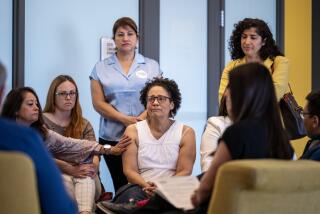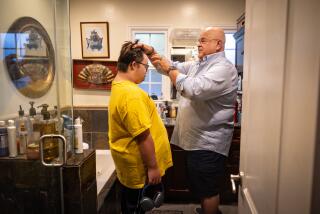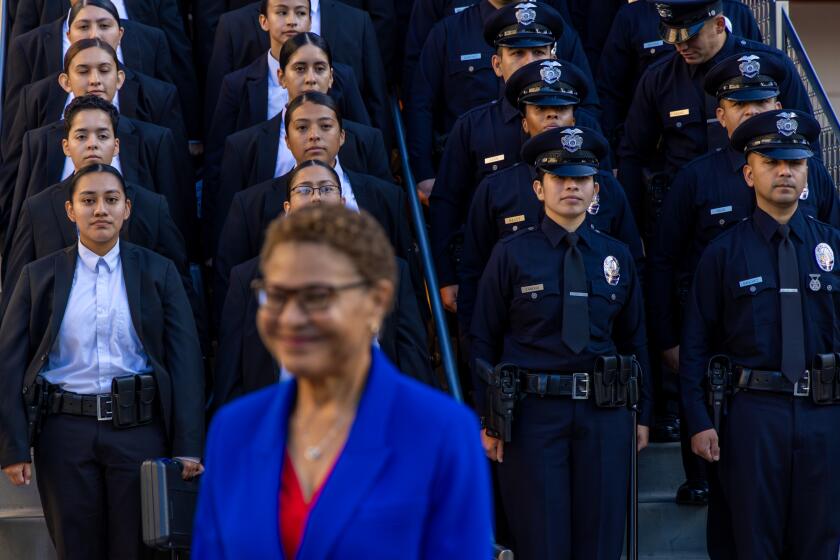Rotarians Help : Children’s Services Gets a New Home
- Share via
Only a month ago, when police brought abused or neglected children to the San Fernando Valley office of the county Department of Children’s Services, there was no place to put them.
Teen-age girls, some victims of incest, would wait, embarrassed, on any spare chair in the crowded work space. Toddlers would cry in a corner or run down aisles of metal desks, jumping over file boxes.
As for infants, almost all of them needed a diaper change. Social workers would clear a desk top, roll up their sleeves and do the job.
But foster care in the Valley has undergone a major face lift.
Wednesday, the Children’s Services staff members held an open house for their new offices on Van Nuys Boulevard in Panorama City. They moved only a block from the offices they shared with the county Public Social Services Department, but the space available to the 140 staff and clerical workers and the children has doubled.
“It was a factory over there, a windowless factory,” said Evelyn Syversten, deputy administrator for Children’s Services.
‘It Was Horrendous’
“The phone system was archaic. There was no place to have a quiet moment to think. The noise volume reached its crescendo at 3 p.m. before everyone collapsed. . . . It was horrendous.”
Syversten said the new offices on the sixth and seventh floors of Panorama Towers are conducive to concentration and provide a more serene atmosphere for the children brought in for foster placement. (About 1,200 children are brought into the county’s foster-care program each month. About 7% end up in the San Fernando Valley office.)
The serenity is due in part to the Woodland Hills Rotary Club, which equipped and decorated three new receiving rooms: a room for infants waiting for emergency foster placement; another for older children; and another where children in foster care can visit their natural parents.
All the rooms were decorated by Sylberta Brodey of Transdesign, who was drafted by Rotary’s Leo Levy for the volunteer work. The rooms were painted and carpeted in pastels. New furnishings were mixed with donated furniture to create a home-like environment. The room for the older children includes a television, a video recorder, books, games, bean-bag chairs, quilts and stuffed animals.
“Children respond differently to being moved,” said Barbara Mudgett, foster home recruiter for Children’s Services. “Some are anxious, some are withdrawn, others are sad or scared. Depending on where those children are, we have things for them. And they don’t have to sit, frightened, in the middle of a busy office.”
The infant’s room houses a crib, swing, rocking chair, television, toys, a microwave to heat formula and a large sink for cleaning the children.
“You can’t imagine what ‘dirty’ really is until you see some of these children,” Mudgett said. “We now have an opportunity to scrape off the first couple layers of grime before a child goes to a foster home.”
Mudgett said she was surprised not only by the Rotarians’ commitment to foster care but by the speed at which they accomplished their goals. (The Rotarians proposed the project in September.)
“When they decide to go for a project, they go for it. They want to know what you want and when you want it delivered. And I’m not used to this. I’m used to the county bureaucracy, which is so much slower,” she said.
Long-Term Assistance
The Rotary Club has other plans for long-term assistance--recognition dinners for Valley foster parents, activity days at Disneyland for foster children, public-relations help for foster-home recruitment and improved medical coverage for the children.
“In this county, each month, we have thousands of abused kids to deal with and some of their stories are harrowing. We felt sorry for these kids and wanted to do something about it,” said Levy, who spearheaded the foster-care project.
In addition to being separated from the cramped welfare building, the facility gains an added advantage in being separate from the negative perception many people have toward welfare assistance, Syversten said.
“We’re not buying into the community attitude toward the welfare client,” she said. “But it’s a difficult prejudice to buck when you’re trying to get support and sympathy for these children.
“This tangible separation is an oblique kind of way to get across to people that it’s not just the welfare client who needs the help of the Department of Children’s Services.”
More to Read
Sign up for Essential California
The most important California stories and recommendations in your inbox every morning.
You may occasionally receive promotional content from the Los Angeles Times.










